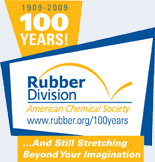![[ Visit ACS Rubber Website ]](images/logo.jpg) |
|
A Key to Enhanced Compatibility and Dispersion in Reinforced Rubber CompoundsTuesday, April 27, 2010: 4:45 PM
Akron/Summit Ballroom (Akron/Fairlawn Hilton Hotel)
Of the total consumption of mineral-based oil worldwide, about 9% is directly related to tire use, or 8 x 106 barrels of oil per day. The year 2012 will witness the introduction of a triple, seven-level labelling system introduced for tires in the European Union on Rolling Resistance, Wet Skid Resistance and Tire Noise. This puts extra emphasis on the need to reduce energy consumption of tires, without compromising all other performance characteristics. With the silica/rubber reinforcement-technology, as introduced by Michelin into passenger tires, a large reduction of rolling resistance has already been achieved. The technology is based on an intricate interaction between: (1) Polymers, specially selected for this application; (2) Easy dispersion silica types developed for the purpose; (3) The development of proper Silane Coupling Agents; (4) Ongoing developments in rubber mixing technology. All were needed to make this silica-technology a success. Developments are continuing to reduce rolling resistance even further. The presentation will cover a review of these technologies, as developed over the last two decades to make this a success. It will highlight the areas of research wherein our research group has contributed and still does.
|
